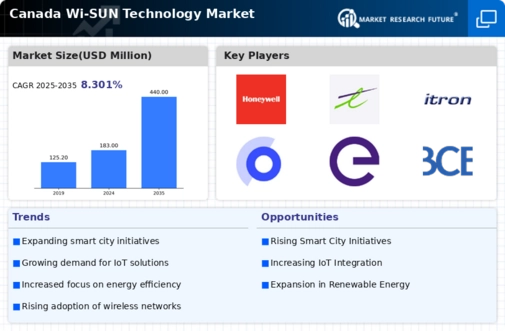Expansion of IoT Applications
The proliferation of Internet of Things (IoT) applications is a key driver for the wi sun-technology market in Canada. With the increasing interconnectivity of devices, there is a heightened need for reliable and scalable communication networks. Wi sun technology offers a robust solution for connecting various IoT devices, particularly in sectors such as agriculture, smart cities, and environmental monitoring. The Canadian IoT market is expected to reach $30 billion by 2026, indicating a substantial opportunity for wi sun technology to facilitate seamless communication among devices. This expansion not only enhances operational efficiency but also supports data-driven decision-making, which is essential for optimizing resource management and improving overall productivity.
Rising Demand for Energy Efficiency
The wi sun-technology market in Canada is experiencing a notable surge in demand for energy-efficient solutions. As municipalities and businesses strive to reduce energy consumption, the integration of wi sun technology into smart grids and IoT applications becomes increasingly appealing. This technology enables real-time monitoring and management of energy resources, which is crucial for optimizing energy use. According to recent data, energy efficiency initiatives in Canada are projected to save approximately 20 TWh by 2030, translating to significant cost savings for consumers and businesses alike. The growing emphasis on sustainability and reducing carbon footprints further propels the adoption of wi sun technology, positioning it as a vital component in the transition towards a more energy-efficient future.
Government Initiatives for Smart Infrastructure
Government initiatives aimed at developing smart infrastructure are significantly influencing the wi sun-technology market in Canada. Various federal and provincial programs are being implemented to promote the adoption of advanced technologies in urban planning and infrastructure development. For instance, investments in smart grid projects and sustainable urban development are expected to exceed $10 billion over the next five years. These initiatives create a favorable environment for the deployment of wi sun technology, as it aligns with the goals of enhancing connectivity and improving energy management. The support from government bodies not only accelerates the adoption of wi sun technology but also fosters innovation and collaboration among stakeholders in the industry.
Increased Focus on Environmental Sustainability
The emphasis on environmental sustainability is driving the wi sun-technology market in Canada. As climate change concerns escalate, there is a collective push towards adopting technologies that minimize environmental impact. Wi sun technology, with its low power consumption and efficient data transmission capabilities, aligns well with these sustainability goals. The Canadian government has set ambitious targets to reduce greenhouse gas emissions by 40-45% below 2005 levels by 2030, which necessitates the integration of innovative technologies like wi sun. This focus on sustainability not only enhances the market potential for wi sun technology but also encourages businesses to invest in solutions that contribute to a greener future.
Advancements in Wireless Communication Technologies
Advancements in wireless communication technologies are playing a pivotal role in shaping the wi sun-technology market in Canada. The continuous evolution of communication protocols and standards enhances the performance and reliability of wi sun networks. As new technologies emerge, such as 5G and low-power wide-area networks (LPWAN), they create opportunities for wi sun technology to integrate and expand its capabilities. The Canadian telecommunications sector is projected to grow at a CAGR of 5% over the next five years, indicating a robust environment for the adoption of advanced wireless solutions. These advancements not only improve connectivity but also enable the deployment of innovative applications across various sectors, further solidifying the relevance of wi sun technology in the market.






















Leave a Comment